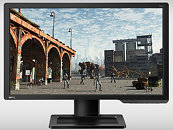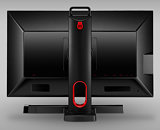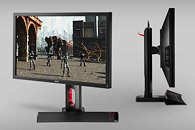Tuesday, December 10th 2013
BenQ to Release Two New 24-Inch Gaming Monitors
BenQ's Gaming Monitor lineup will soon be expanded to include two new models, the 24-inch XL2411Z and XL2420Z. Both displays pack loads of goodies like BenQ's Motion Blur Reduction technology, Flicker-free technology, refresh rates of up to 144 Hz, a 1 ms response time, the Black eQualizer color engine, and adjustable low blue light levels.
BenQ's monitors also have a W-LED backlight, NVIDIA 3D Vision 2 support, a native resolution of 1920 x 1080 pixels, a 1,000:1 contrast ratio, and VGA, DVI and HDMI connectors. The XL2420Z adds to the mix a second HDMI port, a 2-port USB 2.0 hub, and the S Switch remote controller for fast preset changing and OSD navigation. The XL2411Z and XL2420Z have yet to be priced, or dated.
Source:
TFT Central
BenQ's monitors also have a W-LED backlight, NVIDIA 3D Vision 2 support, a native resolution of 1920 x 1080 pixels, a 1,000:1 contrast ratio, and VGA, DVI and HDMI connectors. The XL2420Z adds to the mix a second HDMI port, a 2-port USB 2.0 hub, and the S Switch remote controller for fast preset changing and OSD navigation. The XL2411Z and XL2420Z have yet to be priced, or dated.



25 Comments on BenQ to Release Two New 24-Inch Gaming Monitors
Nothing to see here, move along.
If you are one of those people, do tell. I'd also love to know how people intend to get 144FPS when running at WQHD like 1440p and 1600p.
What do you think? Like $800-1500 for the monitor + tri fire 780ti's for $2100?
You said your ips has no input lag, but every monitor has input lag. Ips typically have more afaik. Is this from your own testing or from a referencable website?
As for input lag, it's from reviews, monitor forums (like 120hz.net) and my personal experience. IPS vs TN has nothing to do with the input lag, it's just a panel. That's like the people who say "but the IPS refresh can't go to 120hz because of the response time of the pixels" or some variation of a stupid comment. The pixels are just LCD pixels, there isn't any difference in the screen between an IPS and a TN (the physical screen, not the panel). The input lag on a monitor comes from the PCB, the inputs and the scaler.
So in other words, the more inputs your PCB has the bigger your PCB is, that adds time for a signal to be displayed. Same thing with the scaler, which is the bigger issue on IPS monitors and why you don't see low input lag 1440p...because even if no scaling is being done, the signal goes through the scaler and it introduces lag because it has to figure out whether or not it needs to scale. A lot of reviews on TFTcentral of IPS monitors have found that whether you scale or run native resolution the input lag is exactly the same, no better or worse.
These Korean panels not only have no scaler, but they use the worlds most simple PCB, the single input means they don't introduce any significant amount of input lag. Even if it was in the 5ms range and not 0ms, that's low enough that you can't notice it. Once you get to 15ms or higher that's where you start to have issues, by the time you get to 30ms where most 1440p monitors are it's very significant. It's a little confusing because when we talk about input lag we really mean Input lag + processing lag. Input lag is related to the number of inputs and the PCB, the processing lag is the scaler issue and is usually the lion's share of the actual lag.
Refresh rate on the other hand is how quickly the panel (and thus pixels) are able to display a frame. A 60hz panel means there is a 16ms delay between frames because that's as fast as the panel can display, so regardless of what the "response time" is you can't get any faster than 16ms. That's the other reason "response time" is stupid, aside from being a worthless GTG measurement, it doens't mean anything unless the refresh rate is faster than the response time.
But again, please re-read my previous post...it's not even the panel that determines the refresh rate, it's the PCB, the scaler and the inputs. There is no such thing as a "physical limit" for IPS panels, it's just a panel. Think of it this way:
LCD pixels are all the same (the screen) there is no difference between LED, IPS, TN, etc. They display the same way no matter what type of panel is driving it. The panels themselves are different, but they all display frames, as far as I know there is no physical limitation difference aside from color range, viewing angle, etc. It isn't the panel that determines the response time or the refresh rate, just how the pixels are controled. The lighting source is also independant of the screen and the panel, today that means it's usually white LEDs. The part that determines your technical specs (like in a computer) is the PCB. How many inputs are there, what kind of scaler does it have, is there processing done on the frames as they are displayed? Those are the questions that determine your refresh rate, your response time and all the nuts and bolts of your screen.
So until the major brands (Asus, BenQ, Samsung, Dell, etc) focus R&D on the PCBs inside IPS panels you won't see a commercially released 120-144hz IPS panel with multiple inputs. That's why some sellers are charging upwards of $700 for an off brand pixel perfect Korean monitor, because you can overclock them without any real input lag to 120hz...
from what i've seen so far, IPSs panels sit around 5ms at the lowest level, my hypothesis above is what i was getting at, i expect 120hz IPS to be doable since the response time is enough time for a pixel to completely change state before it's told to change state for the next frame, so basically i wonder what's taking the companies so long to put out 120hz IPS based models
i'm mostly familiar with how LCDs work, as you said, there's a screen grid of pixels, backlight is unrelated, input lag comes from the pre-processing, but per (sub)pixel is where TN/VA/IPS are different physically, using different methods of rotating & arranging the crystals
i find the 1ms TN panels strange myself, since our eyes cause motion blur, the reason CRTs look much smoother is from the black flicker which i do approve of its usage in LCDs with high refresh rates (this is actually one main reason why i got this benq FP241VW a few years ago, it has an option to control the flicker level, but unfortunately it fades the image too much so i never use it.... it's a VA panel so it looks much better than TN, but there is some horizontal viewing angle issues especially with grey colors, overall i like it since there was very little choice at that time, there was no such thing as $300 IPS back in mid 2008)
The *ONLY* thing that matters on a monitor is how fast the refresh rate is. Let's pretend for a moment that you're not wrong about the response rate (which you are, you're confusing two different things), so hypothetically we have a monitor that has pixels that can "respond" in 5ms. Now you have that monitor running at 60hz, that means that the screen refreshes every 16ms. If a frame gets there before the screen refreshes or after, it tears and introduces lag (stuttering). It doesn't matter that the pixels can respond every 5ms because the refresh rate locks when the monitor looks for a new frame. The refresh rate (as I stated) is determined by the PCB limitations, not the panel or the pixels.
120hz IPS *is* doable, I have a PLS monitor running at 110hz right now and other people have Korean IPS panels running at similar speeds. The limitation isn't the pixel response time, it's the PCB, the scaler and the processing that cause the actual issue. If you have input or processing lag it doesn't matter if your screen refreshes every 8ms (120hz) or faster...because you're getting 20-30ms of delay on EVERY frame. So until they figure out how to get PCBs that eliminate that lag and still keep up the picture quality without getting rid of the scaler/extra inputs...you won't see a 120hz name brand monitor. The Korean ones work because they get rid of all the extra features...
Understand now? Forget the "response" time, it's a meaningless number. If you really wanted the complete change number even TN 1ms panels are closer to the 5-6ms range when you're talking about full color change and not GTG, but don't quote me on that because it's not a verified statistic...
I would say make it 27" but then price would sky rocket.
Good upgrade from my current Samsung 22" regardless.
i think our idea trajectories are getting closer :laugh: , you just said that 1ms or 5ms, it takes time for a pixel to change color, & i am saying... with vsync on to simplify it, the time it takes to change a pixel across all the panel types these days is faster than the interval between each frame coming in from a 120fps source, so i see no limitation with the panel type to maintain vsync 120hz accurately, yet the companies are taking quite a while
what were LCDs like a decade ago? i've only seen a few back then, friend's one was such an incredible blur... probably very high response time as in each pixel takes a while to change color right?
reminds me, last year i was in below freezing temperatures for a couple hours, the display on my phone was ghosting, everything was fading, generally taking a long time to change the image/UI, basically the response time was increased to a very noticeable level & it went back to normal once it was back in room temperature
but the tearing you mentioned brings up an interesting side thought, what exactly is happening when a 1,200fps source is 'sent' to a 60hz LCD? where in the chain does the tearing happen, the data cable probably isnt sending 1,200fps due to its standardized bandwidth constraints, so the gfx card output sends a torn image containing multiple frames 60 times a second? i'll probably see horizontal stripes on screen if it's alternating black & white torn frames, will code this if i have to
if someone tests with FCAT, assuming it clones the output without altering the image, would they see identical tears in identical locations on their monitor compared to the recorded footage? i'm thinking probably... since FCAT has logged the microstutter we see, complete with the torn frames
i've really wanted a high speed camera for years... :rolleyes: (not just for experiments)
we're not disagreeing & i'm not mixing terms, just digging at a low level i want to visualize everything that happens from the moment the gpu sends a complete frame to the buffer to the moment the pixel has completed its change to what it was just told to be
LCDs have gotten faster over the last decade, but honestly my old Samsung LCD (my first one) is pretty much the same as the last one I had and is pretty much the same as the one I have now (when I'm running 60hz). The blur largely comes from the refresh rate, not the response time. LIke I said, if your screen refreshes every 16ms, unless your response time is *slower* than that it won't matter. When you get to 120hz the response time becomes more important because it refreshes every 8ms, which if your response for a full transition is more than 8ms THEN you'll get blur based on response time. Same with 144hz, that refreshes at something like 6ms (don't quote me, not 100%) which makes the full transition even more important. But 144hz monitors usually are 1ms panels, so even if it's 4 times as long for a full transition (not GTG) that's 4-6ms and is still under what the refresh time is.
The bigger reason we get motion blur is the permanance thing, a frame stays on the screen until it's replaced, and when it's replaced it isn't from a blank screen, it's from whatever was there before. So a blue pixel might stay the same or change, a green pixel might stay the same or change...but all that blurs. If you go from black to color it doesn't blur. That's why lightboost works, the backlight flashes 1.3ms after a screen refresh and wipes the screen back to black before the next frame is drawn. That means every transition is black to color and there isn't any blur from color to color transitions. It's like a CRT, CRTs projected image...they never stayed. If your signal cut out the screen just went blank...on an LCD the screen would just "freeze".
As a side note: never game with VSYNC on, it adds major input lag. It's usually worse than what comes with an IPS monitor. I don't have a chart handy, but go look up some of the g-sync articles (like the anandtech review) and I think they have pictures explaining how vsync works. Even G-sync, which is far superior still adds input lag. That's why you want the framerate of the refresh rate, so you don't get tearing and don't need vsync...
ya motion blur can only be reduced by having black flickers, i'm a big fan of how multiple companies are doing this, anyone can experiment with those LED xmas lights vs old style ones or their phone, it's very noticeable how if you move the lights around or smoothly move your head around, you can see the flicker but also a very crisp movement of the lights, while if you do the same with a non flickering lcd or even a piece of white paper, it will have motion blur